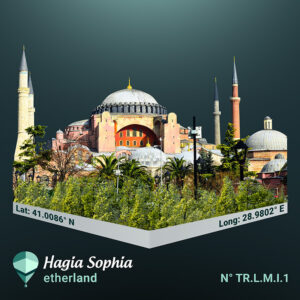 The Hagia Sophia, built in 532 - 537 by the Eastern Roman Emperor Justinian, has been the most important cathedral of Eastern Christianity for centuries. After the Ottoman conquest of Constantinople in 1453, it served as the central mosque of imperial Istanbul and remained the spiritual heart of the Ottoman Empire for the next 460 years.
The Hagia Sophia, built in 532 - 537 by the Eastern Roman Emperor Justinian, has been the most important cathedral of Eastern Christianity for centuries. After the Ottoman conquest of Constantinople in 1453, it served as the central mosque of imperial Istanbul and remained the spiritual heart of the Ottoman Empire for the next 460 years.
Hagia Sophia in Istanbul is one of the most historically significant mosques. It was built as a Christian cathedral in the 530s AD by Justinian I, the head of the Eastern Roman Empire or Byzantine Empire, in what was then the capital named Constantinople. Justinian was the greatest of the Byzantine emperors and had reconquered parts of the western empire in Italy and Tunisia. He built it to be the Cathedral Church of Constantinople, dedicated to the Holy Wisdom, or Logos, the second person of the Trinity, of which Jesus Christ was said to be the manifestation. The church was named Hagia Sophia, meaning ‘Holy Wisdom.
Work on the church began in 532 AD under the direction of the Greek geometers Isidore of Miletus and Anthemius of Tralles. It was completed in just five years. It is a strikingly unusual cathedral church, incorporating eastern and western building traditions. Building material was obtained from throughout the Mediterranean world. The monument measured 82 meters by 73 meters, with its large dome rising 55 meters or 180 feet above ground level. The dome was also over 32 meters in diameter, making it one of the most significant engineering feats ever completed up to that time. Consequently, it was the largest cathedral church on earth when it was built and remained so for centuries to come. Outside, the cathedral was situated on a large plaza or square on which the people of Constantinople could congregate when religious festivals and other events were held within the church. Another striking feature of the monument was the marble flooring within which was praised by medieval writers as resembling the sea when viewed from a height. Unfortunately, the floor was carpeted in 2020.
The subsequent history of Hagia Sophia reflects the wider history of the city in which it was built. The Byzantine Empire lasted for another 900 years, though it was gradually conquered piece by piece from the seventh century, first by the Arabs and then by the Seljuk Turks, a nomadic people from Central Asia who migrated to Anatolia from the tenth century onwards. Constantinople was besieged many times during these years, but it only finally fell to the Ottoman Turks in 1453, bringing the Byzantine Empire to an end. The monument was subsequently converted into a mosque, and in the decades that followed, four minarets or towers were added to the four corners of the monument’s complex. These stand over 200 meters tall and give Hagia Sophia a striking look at the Istanbul skyline.
In the twentieth century, the founder of the modern state of Turkey, Kemal Ataturk, attempted to make Turkey a more secular country. In 1935, he converted the monument into a museum. In 1985 it was made a UNESCO World Heritage Site and became a major tourist attraction. It still performs that role today, but in the last few years, the Turkish president, Recep Tayyip Erdogan, has reconverted it into a mosque.